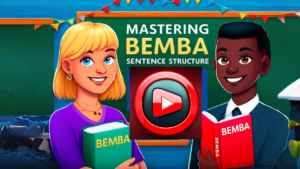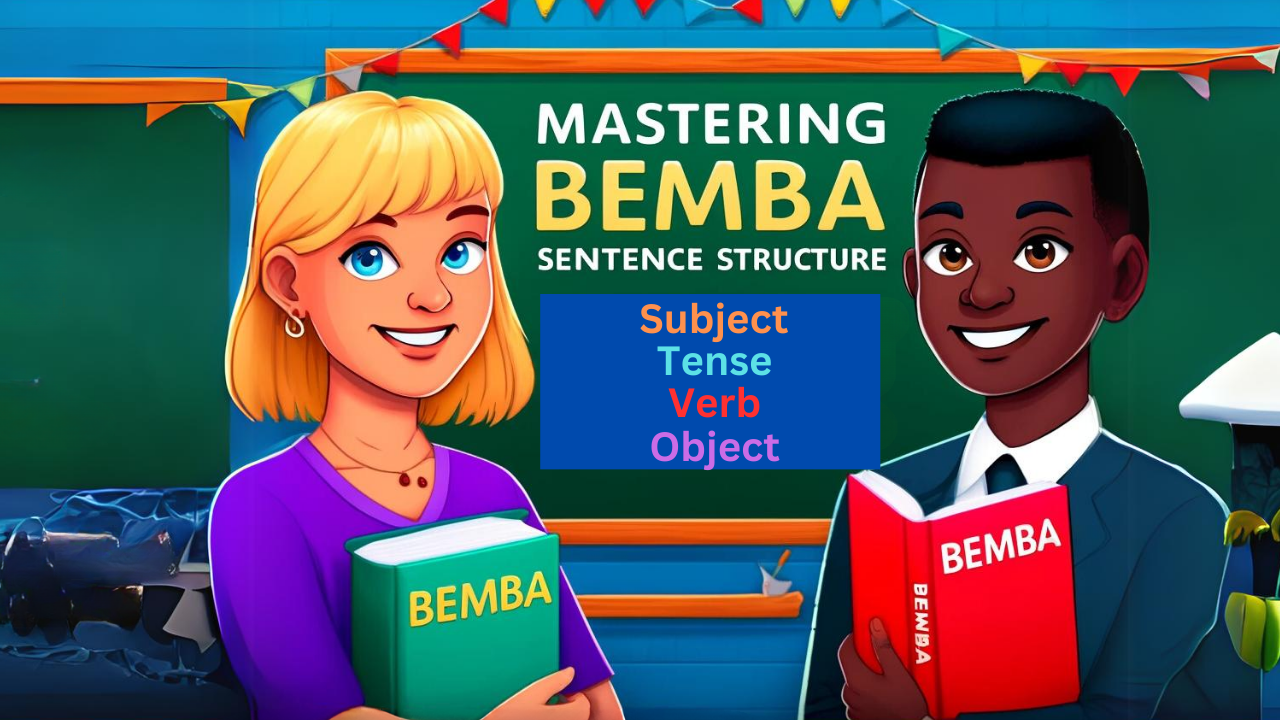Subject – Tense – Verb – Object
Welcome to Bemba lesson number 36.
We’ll look at the structure of Bemba sentences.

Watch YouTube Video
SENTENCE STRUCTURE
A sentence is like a short story.
A good story will tell you all the information you need to know about an event.
–Who is the protagonist?
–What‘s happening?
–When does the plot unfold?
-And whom does it affect?
A Bemba sentence, like any good story, answers all these questions, and more.
The person who did it is also called the SUBJECT.
When, something happens can be described by a lot of different TENSES.
Here, we will just look at four commonly used ones:
1 – Past Tense
2 – Simple Present Tense (Every day)
3 – Present Continuous Tense (Right now)
4 – Future Tense.
In constructing a Bemba sentence, the order of words is as follows:
Subject + Tense + Action Verb + Object.
The Action verb is the heart of the sentence.
Like a train, the verb is led by the subject and tense.
To get to the heart of the story quickly, abbreviations are used for the subject and for the tense.
Shortcuts are used instead of the name of the subject and object, to avoid repeating their names unnecessarily.
PERSONAL PRONOUNS
Personal pronouns are:
I – Ine
You(singular) – Iwe
You(plural) – Imwe
He/She – uyu
They – aba
We – ifwe.
SHORTCUTS
In a sentence, each of these pronouns is carried by a shortcut:
I – n…
You(singular) – u…
You(plural) – mu…
He/She – a…
They – ba…
We – tu…
WORD ORDER
The information comes connected in a particular order.
The shortcut for the PRONOUN is connected to the next piece of information, which is the TENSE. The Verb is introduced after that.
This will become clearer with the use of some example sentences.
EXAMPLES
EXAMPLE 1
PAST TENSE
Take this sentence in PAST TENSE:
I cooked vegetables.
Nali ipika umusalu.
If we color code the sentence to indicate the different pieces of information, we get:
I cooked vegetables.
Nali ipika umusalu.
The “n…” indicates “Who?”
The “…ali” indicates the Past Tense,
Similarly,
SIMPLE PRESENT TENSE(Everyday)
I cook vegetables.
Nda ipika umusalu. (contraction of vowels gives “Nde pika umusalu.”)
If we color code the sentence to indicate the different pieces of information, we get:
I cook vegetables.
Nda ipika umusalu.
The “n…” indicates “Who?”
The “…da” indicates the Simple Present Tense,
PRESENT CONTINUOUS TENSE(Right now)
I am cooking vegetables.
Nde ipika umusalu.
If we color code the sentence to indicate the different pieces of information, we get:
I am cooking vegetables.
Nde ipika umusalu.
The “n…” indicates “Who?”
The “…de” indicates the Present Continuous Tense,
FUTURE TENSE
Lastly, an example in the future tense.
I will cook vegetables.
Nka ipika umusalu.
If we color code the sentence to indicate the different pieces of information, we get:
I will cook vegetables.
Nka ipika umusalu (Vowel contraction makes it “Nke pika umusalu.”)
The “n…” indicates “Who?”
The “…ka” indicates the Future Tense,
Thus we see that the TENSES are indicated by “li”, “la”. “le” and “ka.”
EXAMPLE 2
Now let’s do some exercises.
Exercise 1.
Using this table, see if you can determine who the SUBJECT is for each sentence.
The action verb is TO COME – Uku isa (FUSION: Ukwisa).
Come is “isa”
In the past tense:
- Nali isa
- Mu ali isa (fusion: Mwali isa)
- Bali isa.
- Twali isa.
- Wali isa.
- Ali isa
Here are the Answers:
- Nali isa is I came.
- Mu ali isa (fusion: Mwali isa) is You came.
- Bali isa is They came.
- Twali isa is We came.
- Wali isa is You came.
- Ali isa is He / She came.
EXERCISE 2
For this example, see if you can work out the tense of each sentence:
- Nali isa
- Ule isa
- Mu ka isa (fusion: Mukesa).
- Bala isa (fusion: Balesa)
- Twali isa
- Aka isa (fusion: Akesa)
- Ali isa
Answers:
- Nali isa is Past Tense for “I came.”
- Ule isa is Present Continuous Tense for “You are coming”.
- Mu ka isa (fusion: Mukesa) is Future Tense for “You(plural), will come.”.
- Bala isa (fusion: Balesa) is Simple Present Tense for “They are coming” .
- Twali isa is a Past Tense for “We came”.
- Aka isa (fusion: Akesa) is Future Tense for “He, or she, will come”.
- Ali isa is Past Tense for “He, or she, came”.
This chart, helps you to identify the different personal pronouns at the beginning of a sentence. It also helps to identify the tenses. With the four basic ideas of Who, When, What and Whom, you can make simple sentences that will go a long way in communicating your ideas to your Bemba listener. The secret is to be bold with your efforts and not worry about making mistakes. They are the foundation on which a solid learning process can be built.
Bemba-English / English-Bemba Dictionary now available in Paperback and eBook formats.




Nototela baJS. I learnt a lot from this lesson. But I ask you, if you could explain what prefixes like nici, kwaci, twaci, mwa, na or twa mean. Napatata.
Ba Mutale, thank you for your feedback. That’s an interesting proposal and we will work on it. Thanks.